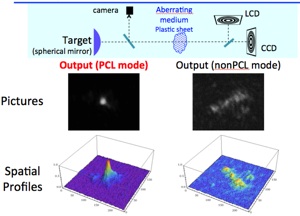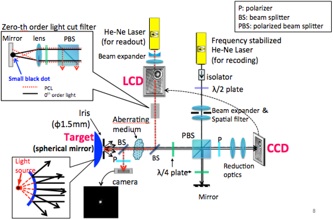Digital Phase Conjugation of Light


For details, please read: K. Kawakami, S. Uchida, and H. Okamura, Evaluation of tracking ability of a phase conjugate mirror using a CCD array and spatial light modulator for optical energy transmission", Applied Optics, 51, No. 10, 1572-1580 (2012)
CCD素子とLCDパネルを用いたデジタル方式の位相共役波の発生
非線形光学を利用したものに比べると媒質のサイズに制限が無く、民生用として入手可能な素子が利用できる、 高い増幅率、異波長が可能、位置や距離情報の同時取得が可能などの特長があります。本研究室では、装置を製作し、その性能評価、長距離伝送の実験、などを行っています。
Introduction
For a long distance optical transmission such as Ground-space optical communication and optical power transmission, an atmospheric disturbance degrades transmission efficiency. There is a need for a wavefront correction technique. Adaptive optics is an established technique but it calls for a guide star, and the system uses a wavefront sensor and precise control of a deformable mirror, therefore, the system tend to be costly, complicated, and slow. Optical phase conjugation correct wavefront without any of the above. It provides tracking, pointing, & amplification at the same time. Phase Conjugation light is a replica of the incident light, and it retraces the incident light. In other words, it reverses the time. Phase conjugation provides the following functions

Digital phase conjugation is based on the same principle as the holography. The interference pattern is recorded on a CCD and it is displayed in real time on a LCD. A laser beam shines the LCD from the backside of the LCD and a phase conjugate light is produced.
1. pointing – light from a point light source is reflected to retrace its original path. →enables aiming powerful laser at a small target.
2. tracking – PCL goes back to the light source even if it is moving.
-
3.amplification –PCL extracts optical energy from readout light. Reflectivity >1 is possible.
Experimental
Up to 6 m of transmission distance is realized so far. The phase aberration is compensated.



デジタル位相共役波